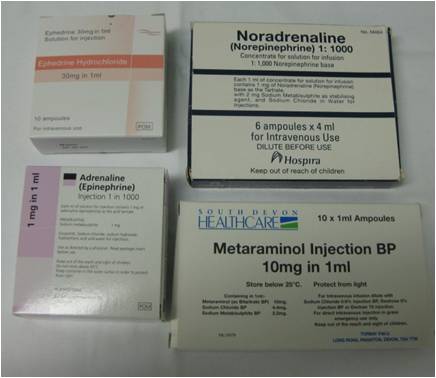Common Drugs Used
Some common drugs used in the pharmacological treatment of intra-operative hypotension are:

Ephedrine
Commonly in 3-6 mg IV boluses. The main action of this drug is to increase presynaptic release of noradrenaline from vesicles at noradrenergic neurones. Ephedrine also has a direct action on α- and β-adrenoreceptors, making it particularly useful when there is hypotension with bradycardia.
Metaraminol
Commonly in 0.25-1 mg IV boluses. This has both direct (mainly on α1-adrenoreceptors) and indirect sympathomimetic actions. It causes a reflex bradycardia mediated by the baroreceptor reflex, so may be preferable to ephedrine when hypotension is accompanied by a tachycardia.
Phenylephrine
Commonly in 50–100 μg IV boluses, or as an infusion (latter often used to prevent spinal-induced hypotension in obstetric anaesthesia). It is a direct-acting sympathomimetic with potent α1-agonist activity and causes a reflex bradycardia via the baroreceptor reflex. Phenylephrine has a shorter duration of action compared to metaraminol.
Noradrenaline and adrenaline
Adrenaline is a potent β-agonist whose actions are mainly inotropic, whereas noradrenaline is a potent α-agonist which is predominantly a vasoconstrictor. Noradrenaline has very little activity on the heart itself. Both drugs should be given via central venous access as an infusion, except in anaphylaxis (this is covered later in this session).